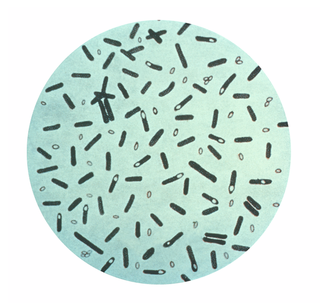
The Clostridiaceae are a family of the bacterial class Clostridia, and contain the genus Clostridium.
The enzyme xanthan lyase catalyzes the following process:
Oxobacter is a genus of Gram-positive obligately anaerobic rod-shaped acetogenic bacteria. The sole species in the genus is Oxobacter pfennigii, formerly known as Clostridium pfennigii. This endospore-forming microorganism catabolizes pyruvate to acetate and CO2, while sugars and amino acids are not utilized as energy sources.
In bacteriology, a taxon in disguise is a species, genus or higher unit of biological classification whose evolutionary history reveals has evolved from another unit of a similar or lower rank, making the parent unit paraphyletic. That happens when rapid evolution makes a new species appear so radically different from the ancestral group that it is not (initially) recognised as belonging to the parent phylogenetic group, which is left as an evolutionary grade.
Thermoanaerobacter is a genus in the phylum Bacillota (Bacteria). Members of this genus are thermophilic and anaerobic, several of them were previously described as Clostridium species and members of the now obsolete genera Acetogenium and Thermobacteroides
Thermoanaerobacter kivui is a thermophilic, anaerobic, nonspore-forming species of bacteria.
Caloramator fervidus, previously known as Clostridium fervidus, is a bacterium belonging to the Bacillota.
Caloramator, is a genus of bacteriae belonging to the Bacillota.
Filifactor villosus, previously known as Clostridium villosum, is a bacterium belonging to the Bacillota.
Filifactor, is a genus of bacteriae belonging to the Bacillota.
Moorella thermoacetica, previously known as Clostridium thermoaceticum, is an acetogenic, thermophilic, strictly anaerobic, endospore-forming, bacterium belonging to the phylum Bacillota.
Moorella thermoautotrophica, previously known as Clostridium thermoautotrophicum, is a rod-shaped, endospore-forming bacterium belonging to the phylum Bacillota. It is thermophilic, strictly anaerobic and acetogenic, and was isolated from a hot spring in Yellowstone National Park USA.
Oxobacter pfennigii, previously known as Clostridium pfennigii, is a bacterium belonging to the Bacillota.
Oxalophagus oxalicus, previously known as Clostridium oxalicus, is a bacterium belonging to the Bacillota.
Oxalophagus is a genus of bacteria belonging to the Bacillota. Up to now, only one species of this genus is known, Oxalophagus oxalicus
Eubacterium barkeri, previously known as Clostridium barkeri, is a bacterium belonging to the Bacillota.
Thermoanaerobacter thermocopriae, previously known as Clostridium thermocopriae is a bacterium belonging to the Bacillota.
Thermoanaerobacterium thermosaccharolyticum, previously known as Clostridium thermosaccharolyticum, is a bacterium belonging to the Bacillota. It is an anaerobic, motile, gram-positive bacterium.
Paenibacillus koreensis is a bacterium. It produces an iturin-like antifungal antibiotic. It is facultatively anaerobic and its type strain is YC300T.
Paenibacillus larvae is a species of bacterium, found worldwide, which causes American foulbrood, a fatal disease of the larvae of honeybees. It is a Gram-positive, rod-shaped bacterium, which forms spores which can remain viable for at least thirty-five years.
